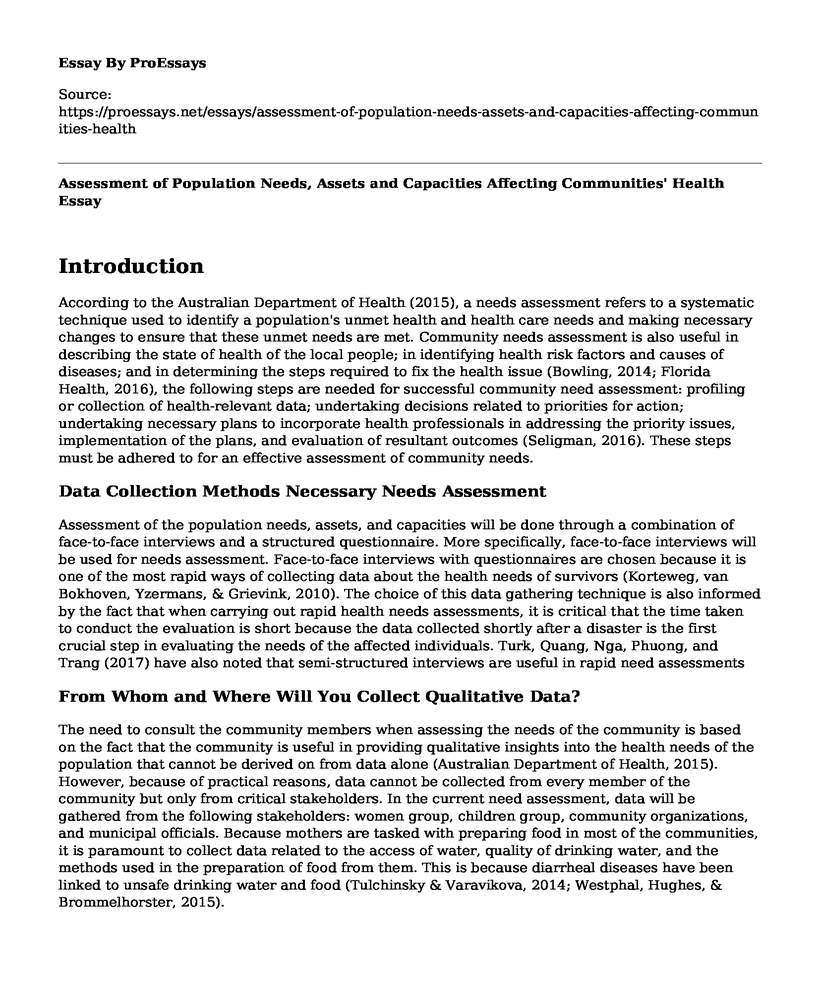Introduction
According to the Australian Department of Health (2015), a needs assessment refers to a systematic technique used to identify a population's unmet health and health care needs and making necessary changes to ensure that these unmet needs are met. Community needs assessment is also useful in describing the state of health of the local people; in identifying health risk factors and causes of diseases; and in determining the steps required to fix the health issue (Bowling, 2014; Florida Health, 2016), the following steps are needed for successful community need assessment: profiling or collection of health-relevant data; undertaking decisions related to priorities for action; undertaking necessary plans to incorporate health professionals in addressing the priority issues, implementation of the plans, and evaluation of resultant outcomes (Seligman, 2016). These steps must be adhered to for an effective assessment of community needs.
Data Collection Methods Necessary Needs Assessment
Assessment of the population needs, assets, and capacities will be done through a combination of face-to-face interviews and a structured questionnaire. More specifically, face-to-face interviews will be used for needs assessment. Face-to-face interviews with questionnaires are chosen because it is one of the most rapid ways of collecting data about the health needs of survivors (Korteweg, van Bokhoven, Yzermans, & Grievink, 2010). The choice of this data gathering technique is also informed by the fact that when carrying out rapid health needs assessments, it is critical that the time taken to conduct the evaluation is short because the data collected shortly after a disaster is the first crucial step in evaluating the needs of the affected individuals. Turk, Quang, Nga, Phuong, and Trang (2017) have also noted that semi-structured interviews are useful in rapid need assessments
From Whom and Where Will You Collect Qualitative Data?
The need to consult the community members when assessing the needs of the community is based on the fact that the community is useful in providing qualitative insights into the health needs of the population that cannot be derived on from data alone (Australian Department of Health, 2015). However, because of practical reasons, data cannot be collected from every member of the community but only from critical stakeholders. In the current need assessment, data will be gathered from the following stakeholders: women group, children group, community organizations, and municipal officials. Because mothers are tasked with preparing food in most of the communities, it is paramount to collect data related to the access of water, quality of drinking water, and the methods used in the preparation of food from them. This is because diarrheal diseases have been linked to unsafe drinking water and food (Tulchinsky & Varavikova, 2014; Westphal, Hughes, & Brommelhorster, 2015).
Additionally, it is essential to collect data from children groups because they are among the most vulnerable group. Most children who die before the age of five have their deaths attributed to climatic-related causes such as diarrheal diseases (Godfrey & Torres, 2016). Thirdly, community organizations, especially the NGOs need to be interviewed because they are at the forefront in providing the community with the resources required to address different health challenges. Consequently, they are in a better position to know what could have led to the outbreak. Also, municipal officials are excellent data sources because they are tasked with supplying the residents with water and in the provision of sanitation.
References
Australian Department of Health (2015). Need assessment guide. Retrieved from https://www.k4health.org/sites/.../Health_Needs_Assessment_A_Practical_Guide.pdf
Bowling, A. (2014). Research methods in health: investigating health and health services. McGraw-Hill Education (UK).
Florida Health (2015). Community health needs assessment. Retrieved from walton.floridahealth.gov/.../community-health.../walton-county-community-health-ass.
Godfrey, P., & Torres, D. (2016). emergent possibilities for global sustainability: intersections of race, class and gender. Routledge Publishers.
Korteweg, H. A., van Bokhoven, I., Yzermans, C. J., & Grievink, L. (2010). Rapid health and needs assessments after disasters: a systematic review. BMC public health, 10(1), 295.
Resnick, J., & Seligman, K. (2017). 9 steps for community assessment. Retrieved from https://www.hhnmag.com/articles/8213-steps-for-community-assessment?bid=1753831
Turk, T., Quang, N. D., Nga, T. T., Phuong, H., & Trang, V. H. (2017). A rapid assessment and response approach for socially marketed nutrition commodities in Viet Nam. Asia Pacific Journal of Clinical Nutrition, 26(1), 182-189.
Westphal, M. I., Hughes, G. A., & Brommelhorster, J. (2015). Economics of climate change in East Asia. Asian Development Bank.
Cite this page
Assessment of Population Needs, Assets and Capacities Affecting Communities' Health. (2022, Sep 15). Retrieved from https://proessays.net/essays/assessment-of-population-needs-assets-and-capacities-affecting-communities-health
If you are the original author of this essay and no longer wish to have it published on the ProEssays website, please click below to request its removal:
- Paper Example on Hourly Rounding Improves Nursing Responsiveness
- Essay on Aging Care in Australia: Need for Increased Spending for Justice
- Essay Sample on Capacity vs Vulnerability: Emergency Preparedness
- Essay Example on Hawaii Nursing: Securing a Future in Healthcare
- COVID-19 and African Americans in NYC: Tough Times, Tough Measures - Essay Sample
- Paper Example on Patients' Communication: Improving Quality of Care at Torin Regional Hospital
- Research Paper Example on Unlocking the Benefits of Internationalizing Higher Education







